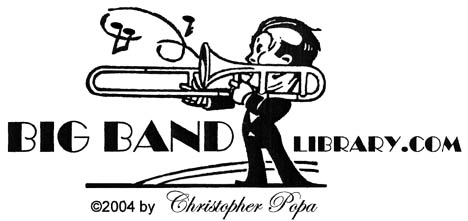
vital stats:
given name Malcolm Gray Hallett
birth 1896, Roxbury, MA
death Nov. 20, 1952, Boston, MA
father a musician
education graduate, English High School, Boston, MA; studied at New England Conservatory
of Music, Boston, MA
military service U.S. Army, World War I
wife Florence
physical description about 6' 5" tall; had wavy hair and a waxed moustache
residence Needham, MA [ 1947 ]
Promoted by famed booking agents Charlie and Cy Shribman, Hallett's band of the early and mid-'30s, which used a tune called Boston Tea Party as its theme, worked every major ballroom around New England and was supposedly "the one-nightingest" of them all.
They also found success in a number of other locales in the East and Midwest, including the Arcadia and Roseland ballrooms and the Green Room of the Hotel Edison in New York City.
In 1937, Hallett played a "battle of the bands" with Count Basie's orchestra in Buffalo, NY.
"Mal led his group up onto the stage and then dazzled the crowd with a combination of power driven arrangements and novelty tunes," historian Robert Melvin later recalled. "Basie said, 'Mal had the greatest band going.'"
Sidemen who were in Hallett's group included, at various times, Dale McMickle and Don Fagerquist (trumpet), Brad Gowans (cornet and valve trombone), Jack Jenney, Lou McGarity, and Jack Teagarden (trombones), Toots Mondello (alto saxophone), Buddy Wise (tenor saxophone), Frankie Carle (piano), and Gene Krupa (drums).
Among Hallett's vocalists were Teddy Grace, a female with a husky, jazz style, and Clark Yocum, who also played guitar and was later a member of The Pied Pipers singing group.
But, one by one, they left Hallett and other, newer big bands instead captured the public's attention.
His orchestra recorded for various record labels, including eight sides on Vocalion in 1936 and some four dozen for Decca between 1936 and 1938.
Hallett's popular discs were (Have You Forgotten) The You and Me That Used to
Be, In the Chapel in the Moonlight, Turn Off the Moon, and One in a Million, though none of them were major hits.
He remained active as a bandleader throughout the 1940s and into the early '50s, and accompanied singer Patti Page when she performed a tour of dates around New England in 1950.
Only a couple years after that, Hallett suffered a heart attack and died at a local hospital a few hours later.
sources:
Roger D. Kinkle, "Hallett, Mal," in The Complete Encyclopedia of Popular Music and Jazz
1900-1950: Volume 2 Biographies A Through K (New Rochelle, NY: Arlington House
Publishers, 1974), p.1035.
"Mal Hallett," New York Times, Nov. 22, 1952, p.23.
Robert Melvin, "Mal Hallett," Joslin's Jazz Journal, Volume 17 - No.4 / Nov. 1998, pp.9-11.
Brian Rust, "Mal Hallett and His Orchestra," in The American Dance Band Discography
1917-1942: Volume 1 Irving Aaronson to Arthur Lange (New Rochelle, NY: Arlington
House, 1975), pp.714-717.
George T. Simon, "Mal Hallett," in The Big Bands (New York City: The Macmillan Company,
1967), pp.230-231.
Leo Walker, "Mal Hallett," in The Big Band Almanac (Pasadena, CA: Ward Ritchie
Press, 1978), pp.165-166.
Joel Whitburn, "Mal Hallet [ sic ] & His Orchestra," in Pop Memories 1890-1954:
The History of American Popular Music (Menomonee Falls, WI: Record Research, Inc.,
1986), p.190.
I would like to expand this tribute with, if possible, a new interview of someone who was important to Mal Hallett's life or career. Are you an alumnus of his band, a member of his family, or a collector who is knowledgeable about his accomplishments? Please contact me via e-mail
return to "Biographical Sketches" directory
go to Big Band Library homepage
The big bands are back
in a new and exciting way!
MAL HALLETT
"AN EARFUL OF MUSIC"
by Music Librarian CHRISTOPHER POPA
November 2008
As a young man, he played the violin and, later, the alto saxophone.
When he formed his first band, they worked from a base in Boston. Their initial engagement was at the American House there and his music became quite popular during the "roaring '20s" around the New England area.
By 1929, the year of a huge stock market crash in the U.S., Hallett's gross earnings topped $60,000.
Around 1930, he fell and broke his arm in five places. While recuperating, he contracted a severe case of pneumonia and incorrectly was diagnosed with tuberculosis. Doctors prescribed a long period of rest, which he took in Arizona.
Following his return to the business, he gave up both the violin and alto sax in favor of waving a baton.
His new band, organized in 1931, offered a solid beat for dancers and gave several future swing era leaders some early experience.
